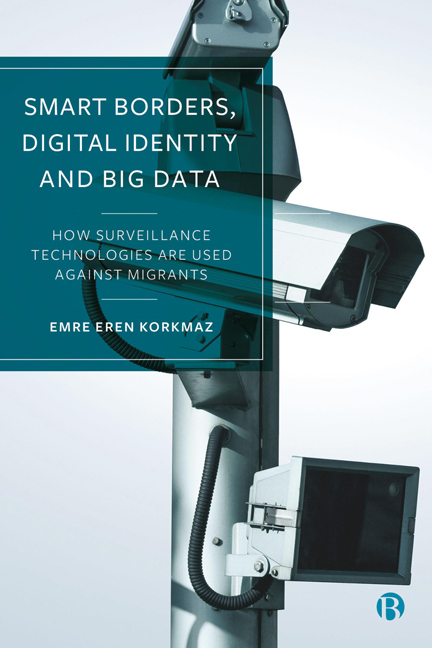 Smart Borders, Digital Identity and Big Data
Smart Borders, Digital Identity and Big Data Book contents
- Frontmatter
- Dedication
- Contents
- List of Abbreviations
- About the Author
- Acknowledgements
- Introduction: Canaries in the Coal Mine
- 1 Migration and (Surveillance) Capitalism
- 2 Migration and (Big) Data Analysis
- 3 Smart Borders
- 4 Digital Identity and Surveillance Capitalism
- Conclusion: How Can We Resist?
- Notes
- References
- Index
1 - Migration and (Surveillance) Capitalism
Published online by Cambridge University Press: 27 March 2024
- Frontmatter
- Dedication
- Contents
- List of Abbreviations
- About the Author
- Acknowledgements
- Introduction: Canaries in the Coal Mine
- 1 Migration and (Surveillance) Capitalism
- 2 Migration and (Big) Data Analysis
- 3 Smart Borders
- 4 Digital Identity and Surveillance Capitalism
- Conclusion: How Can We Resist?
- Notes
- References
- Index
Summary
There is a large body of literature on the relationship between capitalism and migration. Structuralist, Marxist and Marxist-influenced theories examine migration from different perspectives, but mainly in terms of exploitation and relations of dependency; analyses that were particularly popular in the 1970s but remain relevant. There are many studies on how capitalism uses migrants as a labour force to increase surplus-value extraction and to lower wages, and on the tactics used by labour unions to organize migrants in different countries. Similarly, many studies deal with the consequences of migration, both for origin and destination countries (from ‘developing’ countries to ‘developed’ capitalist countries), the effects of remittances, the issue of brain drain and continuing colonial ties and racism. There is also an extensive number of studies that adopt a gender approach, for example the migration of women – particularly from countries such as the Philippines and Ethiopia – to work in domestic services, conditions of modern slavery, and the supply chain of care for children and the elderly at the global level (such as scenarios where a Filipino mother looks after the child of a middleclass German mother, whereas the Filipino mother’s child is looked after by another woman in her country of origin). Moreover, some studies examine the precarious working conditions faced by migrants to capitalist countries, and migrations among the emerging and more economically dependent countries called the Global South. Overall, these studies analyse the approach adopted by capitalism to migration – of labour, in particular – in different periods and countries (Zelinsky, 1971; Amin, 1974; Gilroy, 1993; Escobar, 1995; Anderson, 2000; Arango, 2000; Bigo, 2002; Creswell, 2006; Castles and Wise, 2007; Raghuram, 2009; Castles, 2010; Gardner, 2011; Cabanes and Acedera, 2012; Browne, 2015; Massey, 2015; Francisco, 2018).
In this chapter, I will make use of the accumulated findings and analyses of this literature, but I will not limit myself to the consequences of capitalist policies in the field of migration; I will also argue, making references to the surveillance technologies developed, that migration and border management policies and practices provide valuable data on the internal evolution and trajectory of capitalism.
- Type
- Chapter
- Information
- Smart Borders, Digital Identity and Big DataHow Surveillance Technologies Are Used Against Migrants, pp. 16 - 45Publisher: Bristol University PressPrint publication year: 2024
